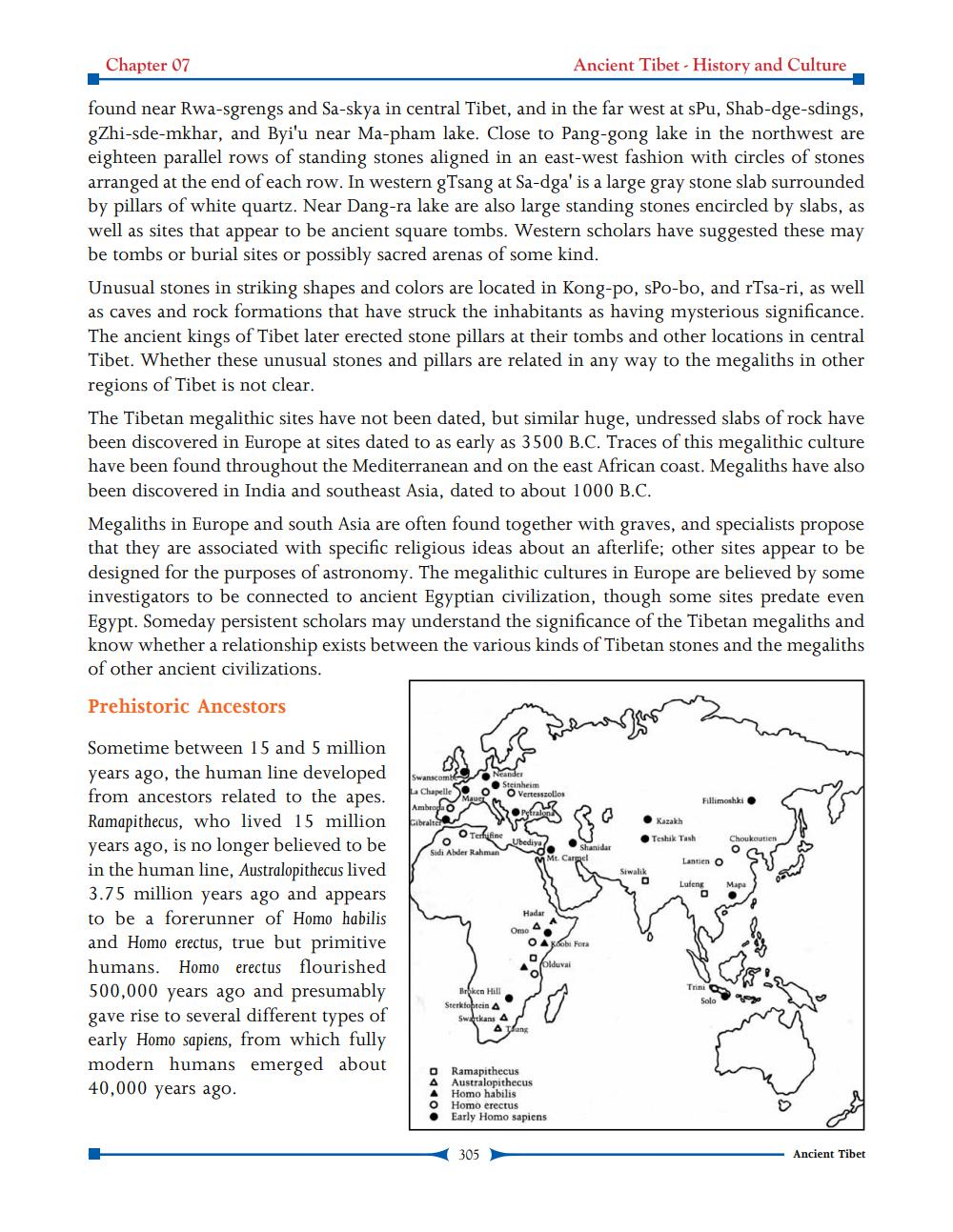________________
Chapter 07
Ancient Tibet - History and Culture
found near Rwa-sgrengs and Sa-skya in central Tibet, and in the far west at sPu, Shab-dge-sdings, gZhi-sde-mkhar, and Byi'u near Ma-pham lake. Close to Pang-gong lake in the northwest are eighteen parallel rows of standing stones aligned in an east-west fashion with circles of stones arranged at the end of each row. In western gTsang at Sa-dga' is a large gray stone slab surrounded by pillars of white quartz. Near Dang-ra lake are also large standing stones encircled by slabs, as well as sites that appear to be ancient square tombs. Western scholars have suggested these may be tombs or burial sites or possibly sacred arenas of some kind. Unusual stones in striking shapes and colors are located in Kong-po, sPo-bo, and rTsa-ri, as well as caves and rock formations that have struck the inhabitants as having mysterious significance. The ancient kings of Tibet later erected stone pillars at their tombs and other locations in central Tibet. Whether these unusual stones and pillars are related in any way to the megaliths in other regions of Tibet is not clear. The Tibetan megalithic sites have not been dated, but similar huge, undressed slabs of rock have been discovered in Europe at sites dated to as early as 3500 B.C. Traces of this megalithic culture have been found throughout the Mediterranean and on the east African coast. Megaliths have also been discovered in India and southeast Asia, dated to about 1000 B.C. Megaliths in Europe and south Asia are often found together with graves, and specialists propose that they are associated with specific religious ideas about an afterlife; other sites appear to be designed for the purposes of astronomy. The megalithic cultures in Europe are believed by some investigators to be connected to ancient Egyptian civilization, though some sites predate even Egypt. Someday persistent scholars may understand the significance of the Tibetan megaliths and know whether a relationship exists between the various kinds of Tibetan stones and the megaliths of other ancient civilizations. Prehistoric Ancestors
wan.com
Neander
La Chapelle S.
O
Steinheim
Vertesszollos
Fillimoshki
Gibralter
Kazakh Teshik Tash
Telefone Ubediya
Choukautien
Sidi Abder Rahman
da
Shanidar
M Mt. Car
Lantien o
Siwalik
a
Lufeng
Mapa
Hadar
Sometime between 15 and 5 million years ago, the human line developed from ancestors related to the apes. Ramapithecus, who lived 15 million years ago, is no longer believed to be in the human line, Australopithecus lived 3.75 million years ago and appears to be a forerunner of Homo habilis and Homo erectus, true but primitive humans. Homo erectus flourished 500,000 years ago and presumably gave rise to several different types of early Homo sapiens, from which fully modern humans emerged about 40,000 years ago.
O A Kabi Fora
Broken Hill Sterktotein A Swatians A
Δ τμης
O A A O •
Ramapithecus Australopithecus Homo habilis Homo erectus Early Homo sapiens
305
Ancient Tibet




